My friends and family know how much I love giving presents, and how much I love plants. As an herbalist, over the years my gifting has shifted towards handmade herbal products to nourish the body, mind, and spirit of my loved ones.
When gifting herbal preparations, it’s important to make them fun, delicious, and festive! I definitely have relatives who would liken receiving a bottle of herbal medicine to a lump of coal in their stocking, but who would be excited about a beautiful and thoughtful tea blend to enjoy together as the nights grow longer.
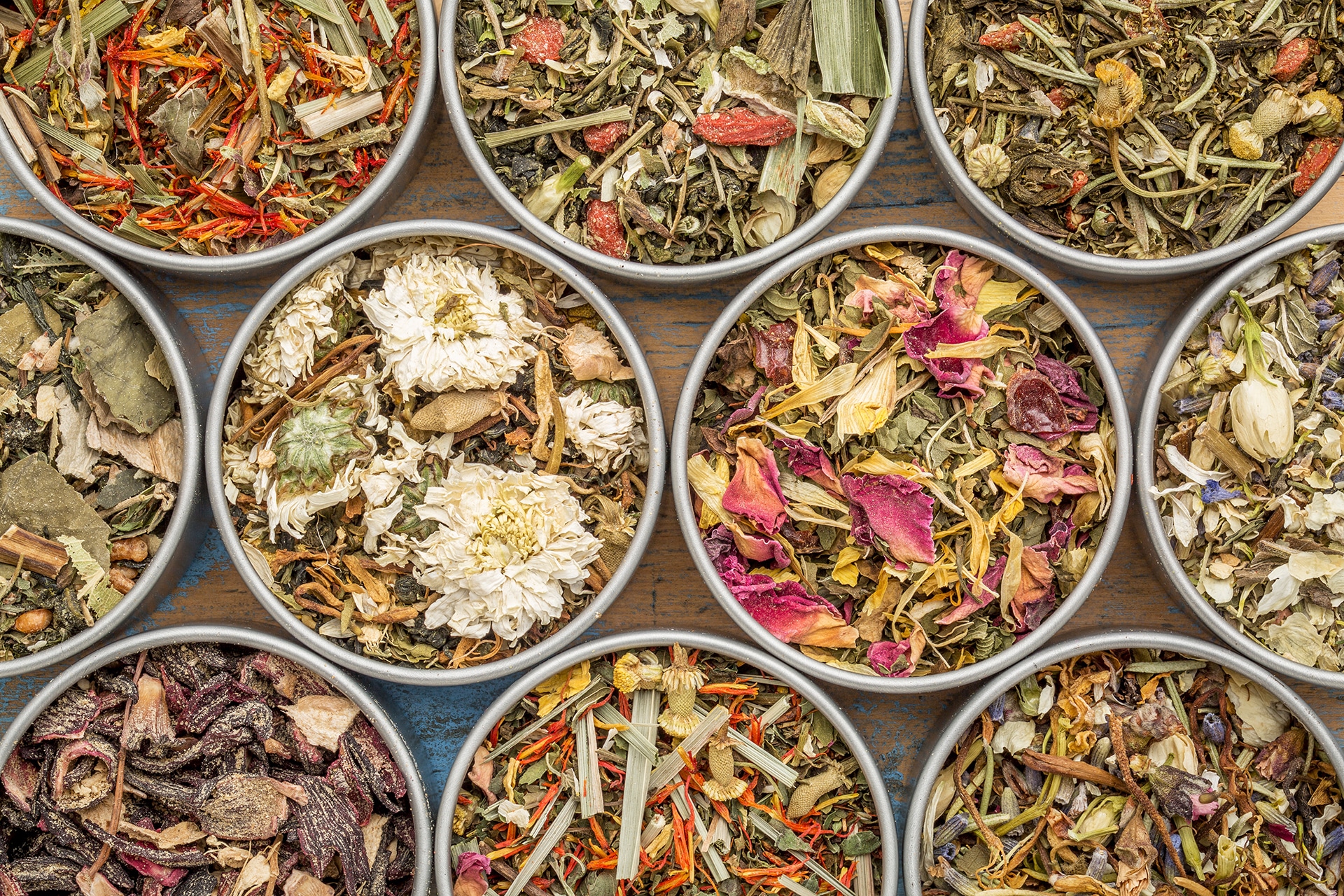
How Do You Make Herbal Tea Blends?
Have you, like me, stood in the tea aisle of a grocery store looking at all the cellophane wrapped boxes, wondering…
Which one is right for me and my family?
Who created these blends?
And how did they know which dried herbs to mix?
If yes, you’re asking the right questions! For teas made by herbal companies, there were likely many herbalists who created — or formulated — each tea blend. Luckily for you, you don’t have to call yourself a “blendmaster” to experiment with and enjoy your own tea blends. If you know what individual herbs taste like and how they help support your health, you’re well on your way. And even better, your loved ones will be able to taste the care and intention you put into each personalized blend.
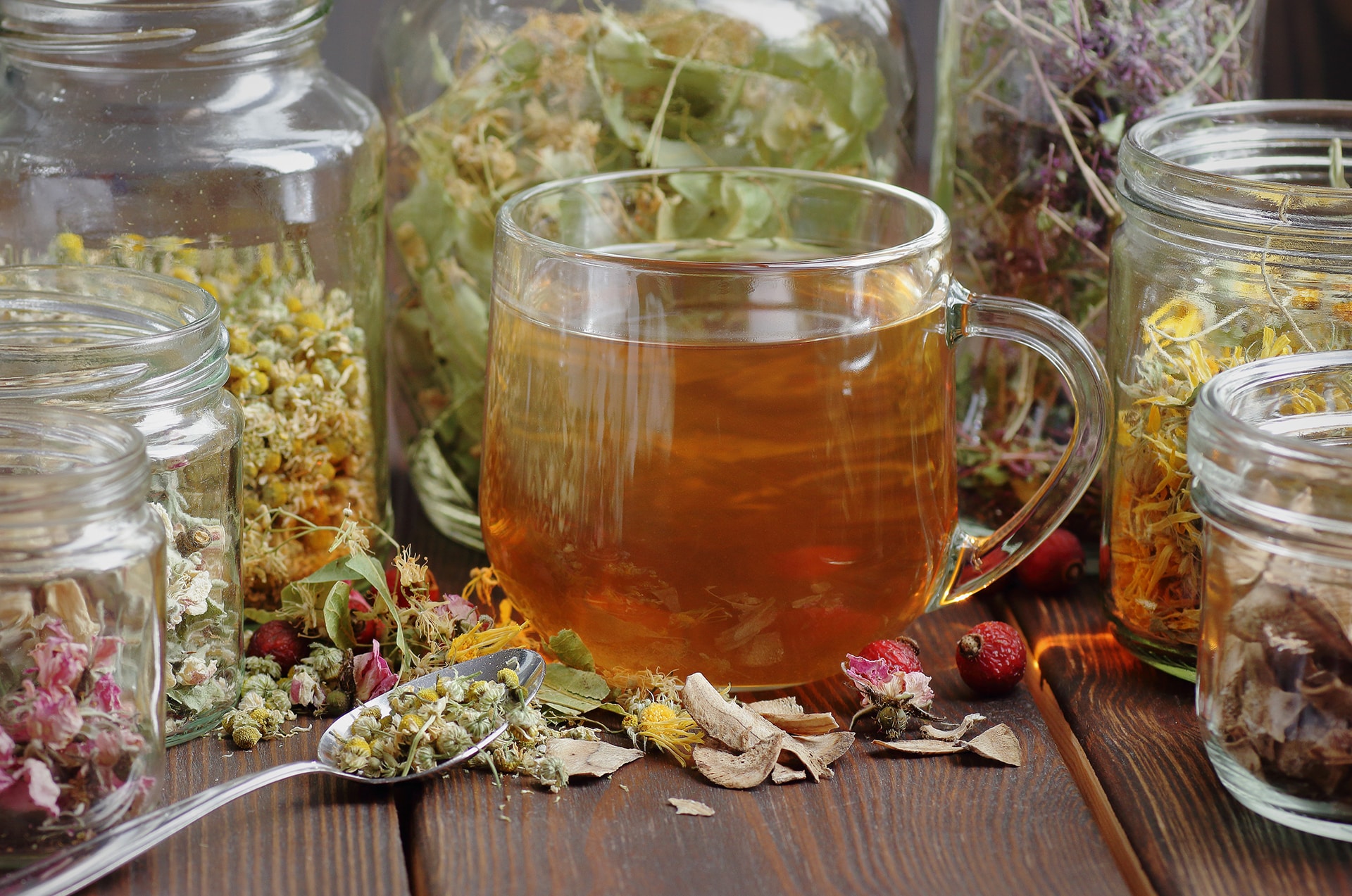
The 3 P’s of Making an Herbal Tea Blend
Just as with other herbal preparations like tinctures or oxymels, herbalists call the act of creating a specific tea blend a formulation. A formula is a recipe that can be replicated over and over again. Think about cooking or baking — while some people enjoy “winging it” and tossing any amount of ingredients into a pan or bowl and being surprised about the results — I have just as much fun and creativity when measuring specific ingredients and tweaking the recipe a little bit each time.
The same goes for a tea recipe – I like to keep track of the ratio of herbs so that I can make it again when a loved one requests another batch! To formulate an herbal blend, I remember the 3 main players as the 3 P’s: the person, the plants, and the purpose.
The Person Who Will Receive Your Herbal Tea Blend
When creating a tea blend as a gift for one person, it’s helpful for herbalists to know some things about them. What tastes do they like: floral, bitter, sour, and/or sweet? Does this person tend to be hot or cold, damp or dry? Do they enjoy tea hot or iced? Are they taking any medications that interact with specific herbs? Tea blends are a lovely herbal gift even if you don’t know someone’s full medication list, as a daily mug of tasty tea is a low enough dose of herbs to not interact with most pharmaceuticals.

The Plants in Your Herbal Tea Blend
When deciding which herbs to mix in a tea blend, I like to know some of the characteristics of the individual herbs. Which part of the plant should I use: roots, leaves, flowers, or fruit? What are their effects on the human body? What do they taste and smell like? How strong is their flavor? Will this herb’s flavor overpower other herbs I want in my blend? Should they be steeped in hot or cold water, and for how long?
The Purpose of Your Herbal Tea Blend
Here’s where it all comes together. This is the goal of how the plants will interact with the person to have a desired physiological effect from drinking the tea. Consider which body systems you are targeting: digestive, respiratory, immune, or others? Should this blend have effects on the body’s tissues of nourishing, moving, cooling, or warming?
The more you’ve studied herbalism, the more specific you can get here. But rest assured, even if you’re newer to herbalism and experimenting with formulation, you can trust your body and your taste buds to make great tea blends that fit with your own goals. Making herbal tea blends is a great place to start getting creative with herbalism. Steeping a mug of tea for just 20 minutes will deliver flavor and function in a low-dose remedy that is generally safe for most people, regardless of their age or state of health.

How Do You Measure Herbs for Your Tea Blend?
When herbs are dried and ready for a shelf-stable tea blend, they are in the form that herbalists call cut and sifted or garbled. (To learn more on how to dry and store herbs, check out Kimberly’s blog post here!) The various roots, leaves, flowers, and fruits that herbalists use in tea blends are all different weights and sizes, so finding a replicable form of measurement for blending and dosing your tea is important. You could measure by volume, scooping herbs by the tablespoon, or if you have a kitchen scale, you can weigh each portion of individual herbs by the ounce or gram. For the warming tea recipe, I measured by volume with tablespoons.
The Benefits of the Herbs in this Winter Warming Herbal Tea Blend
This tea blend contains plants that are supportive during colder months. Overall, it is warming, fruity, calming, and nutritive — perfect for a cold winter’s day. Before we dive into the recipe, I want to share some specific benefits for each herb that I selected for this tasty tea blend. All of these herbs offer many healing gifts, and here are the benefits I had in mind while formulating this blend.

Benefits of Anise Hyssop (Agastache foeniculum)
Anise hyssop acts as a decongestant and expectorant, clearing out mucus from the respiratory system. During the winter months of cold and flu season, this is especially beneficial. The leaves and flowers of anise hyssop taste like licorice, and have calming effects for the nervous system.

Benefits of Echinacea (Echinacea purpurea)
Echinacea leaf and flower are more floral and less bitter than the roots, but still function as immune stimulants with antimicrobial properties. That means whether you’re not sick, or got sick, echinacea can help clear pathogens out of your body faster.
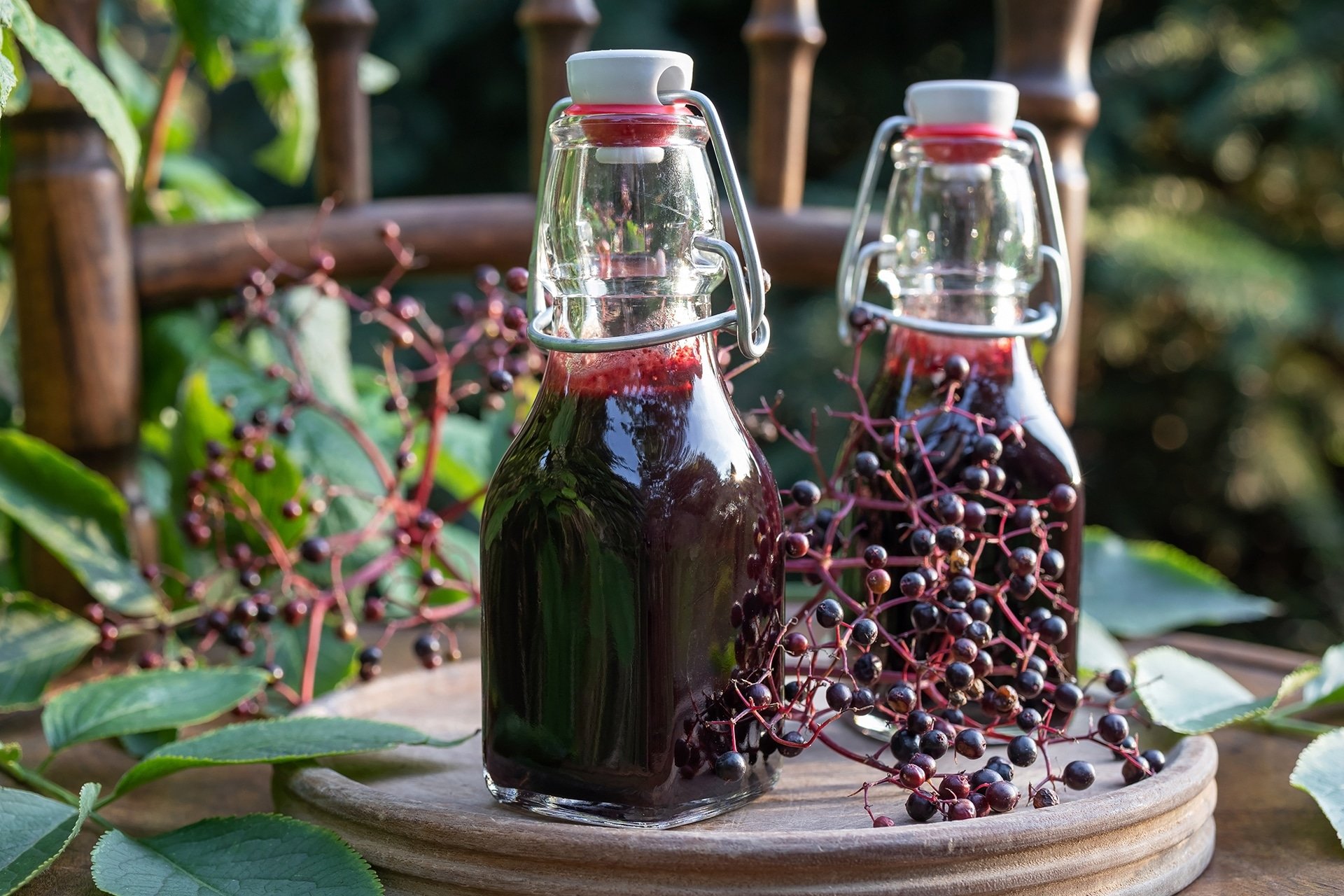
Benefits of Elderberries (Sambucus nigra)
Most well known in the form of elderberry syrup, elderberries are also delicious in a tea blend and will give it a beautiful pink color. As a fruit, they are high in the antioxidant vitamin C, repairing tissues throughout the body. Elderberries have antiviral properties and are very helpful for preventing and managing infections, especially in the upper respiratory system.
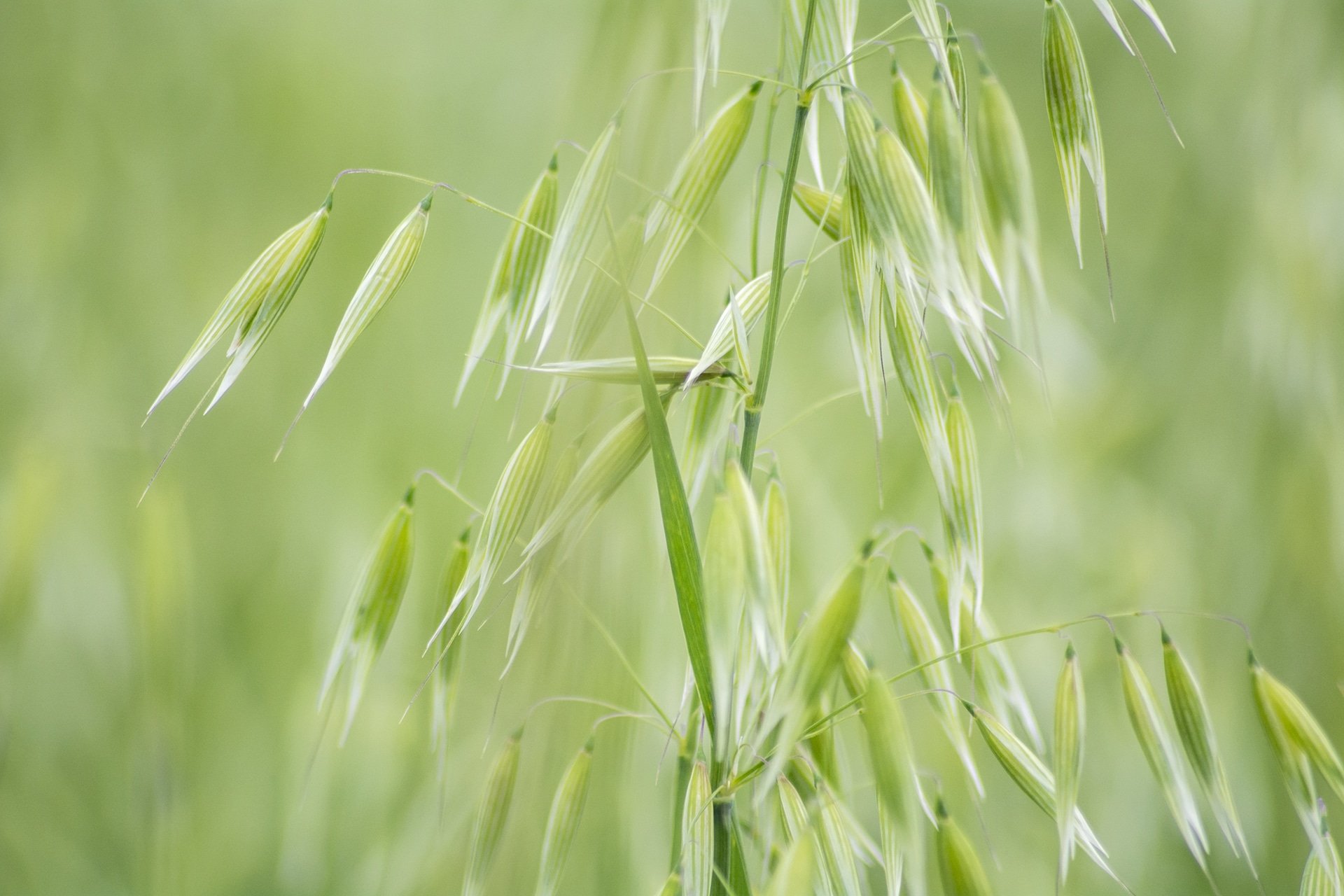
Benefits of Oatstraw (Avena sativa)
Oatstraw is nutritive and mineral-rich, which is helpful to nourish and fortify the body year round, but especially during the winter when many people tend to eat fewer fresh fruits and veggies. Just like a steaming bowl of oatmeal, oatstraw helps build up vitality and replenish depletion from stress or illness.
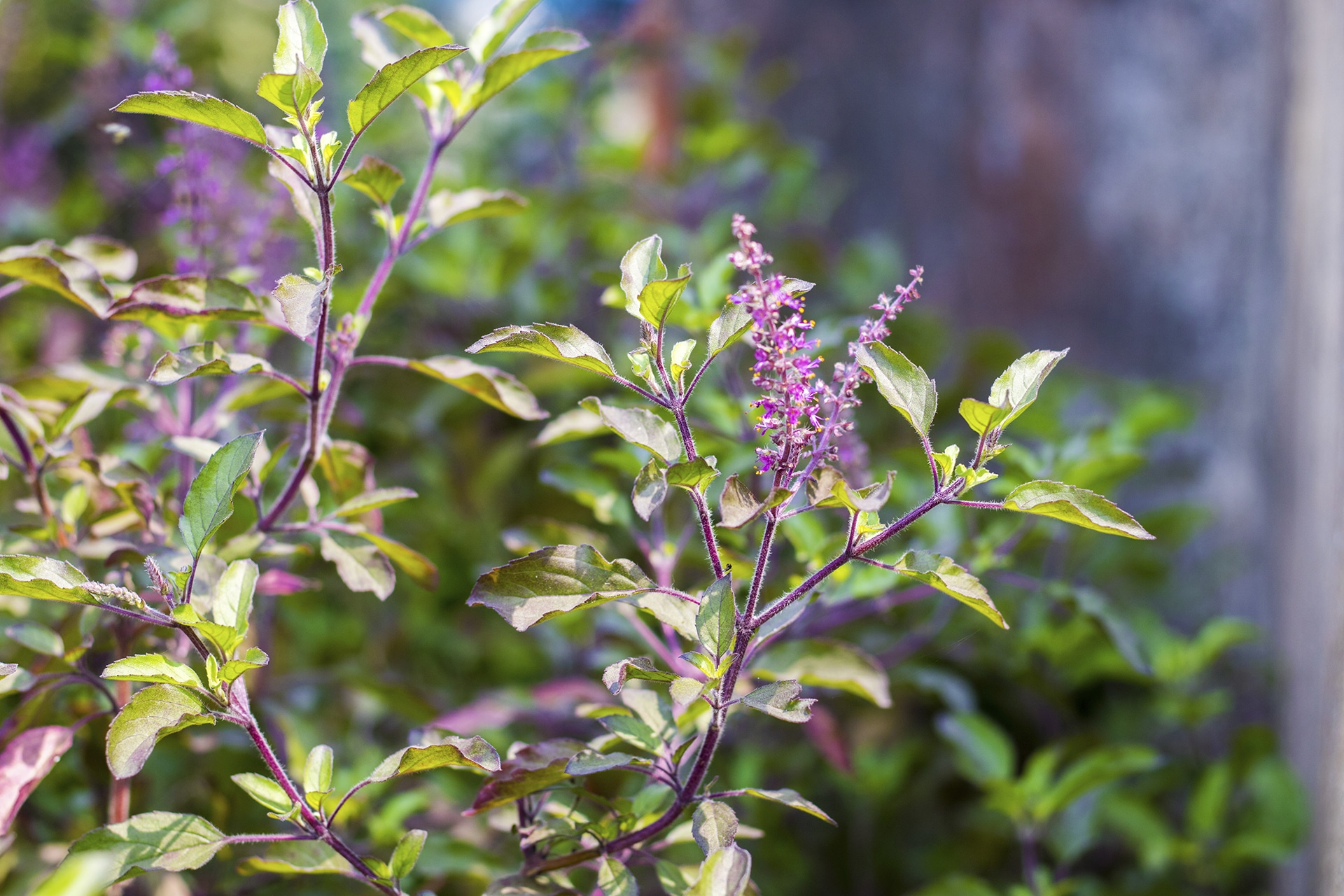
Benefits of Tulsi (Ocimum tenuiflorum)
Also known as Holy Basil, Tulsi is a warming adaptogen for deep immune support. Tulsi’s floral pungency is calming and uplifting for the nervous system and helps relieve gas in the gastrointestinal system.
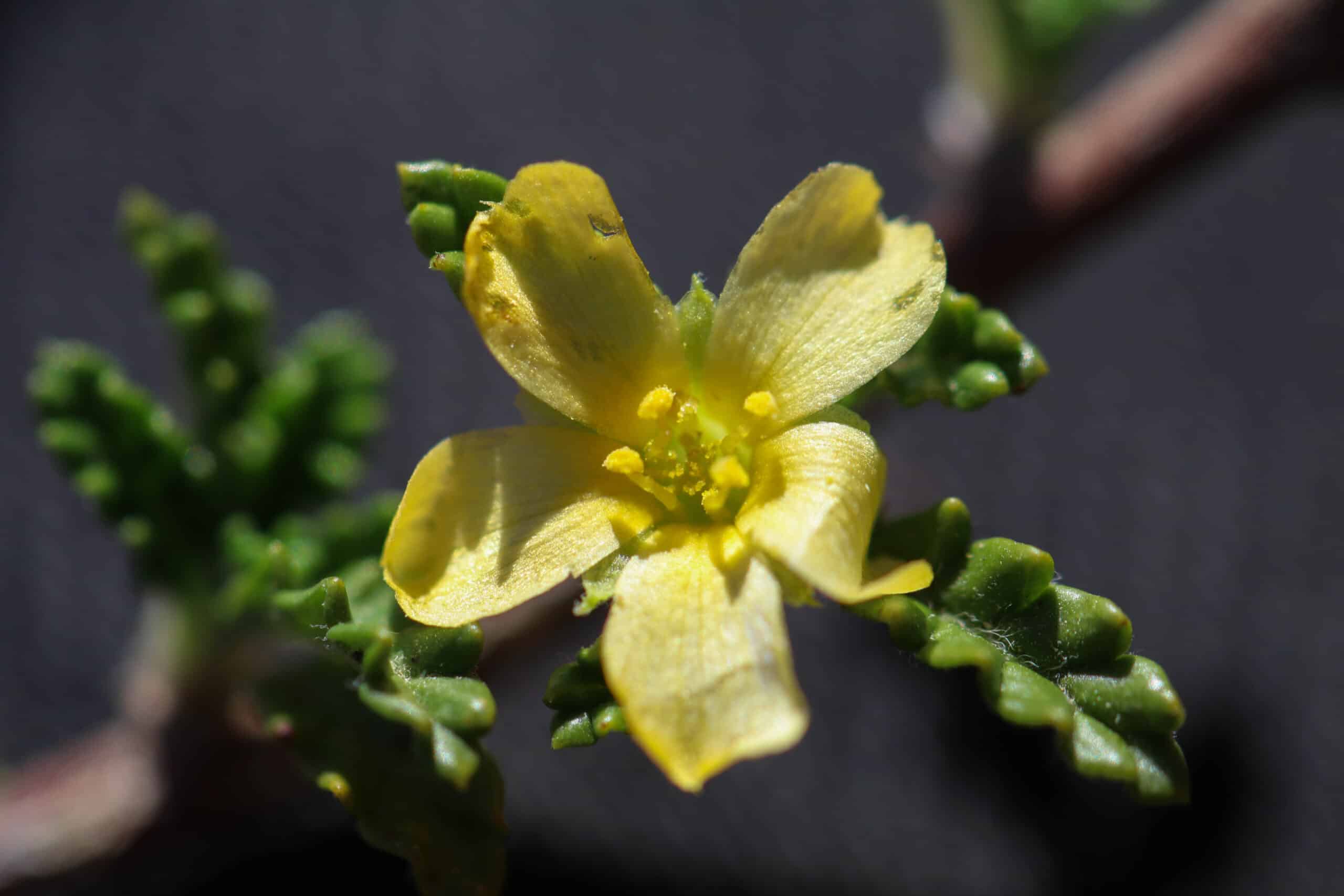
Benefits of Damiana (Turnera diffusa)
Damiana rounds out our formula with its immediate warming, calming, and sweet presence. Referred to as an aphrodisiac, I add damiana to tea blends to bring my attention back to my own body, helping me to ground and center and access feelings of joy.
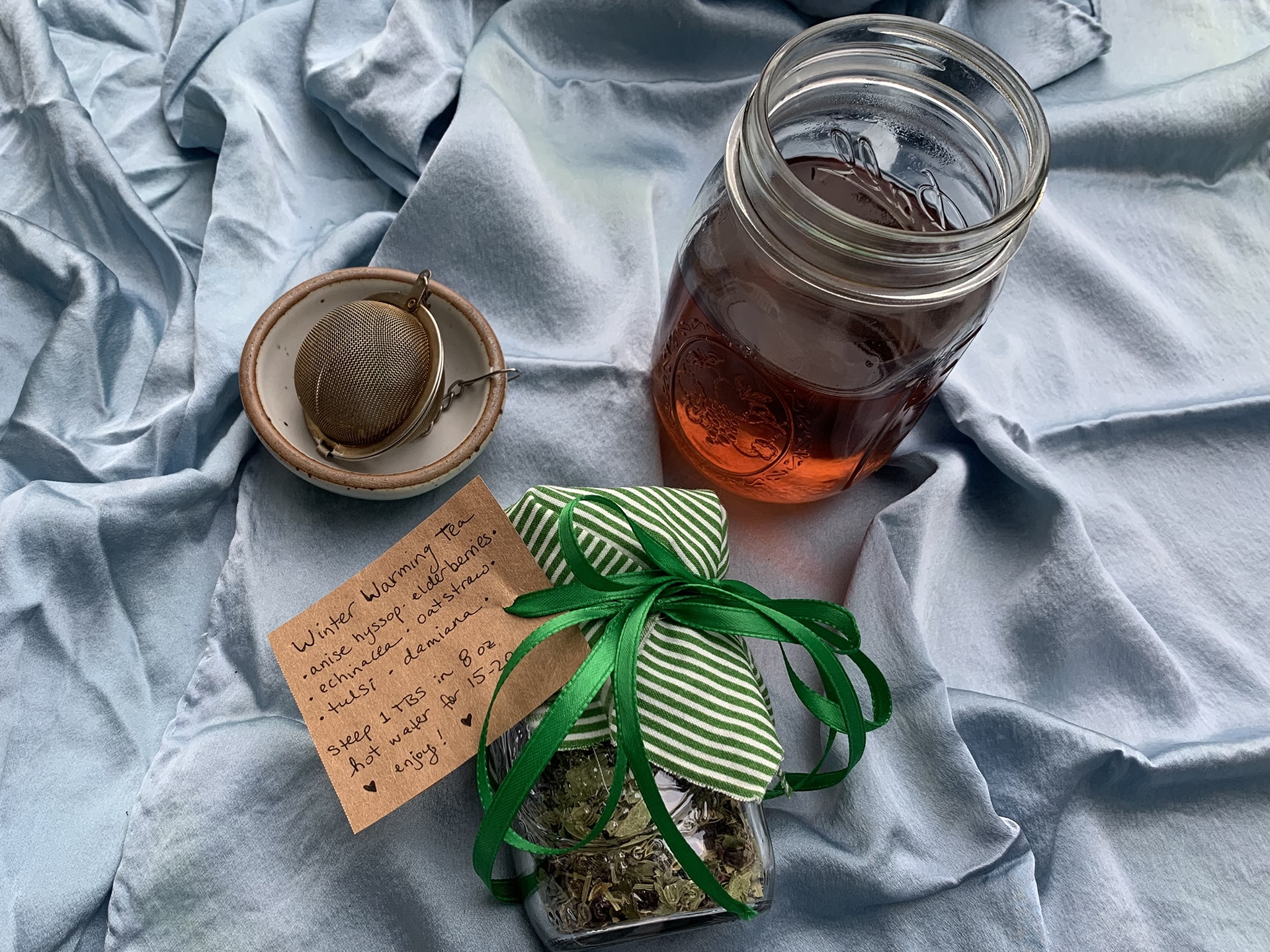
The Winter Warming Tea Blend Recipe
Handcrafted herbal tea blends make for a simply beautiful gift for friends and family. Here’s how to make your own…
Ingredients you’ll need…
- 2 T anise hyssop
- 2 T echinacea leaf + flower
- 2 T elderberries
- 2 T oatstraw
- 2 T tulsi
- 1 T damiana
Supplies You’ll Need…
- Tablespoon (TBS) measure
- Medium mixing bowl
- ½ pint (8 oz) glass jar with lid
- Craft paper
- Pen
- Small piece of thin cloth
- Scissors
- String or ribbon
- Measure out all dried herbs in your mixing bowl, gently stir well.
- Scoop them into your glass jar, put the lid on.
- Cut a circle from the cloth about twice as big as your jar lid, place it over the lid, and attach with string or ribbon around it.
- Write your ingredients and recommended use on the craft paper, cutting to appropriate size.
- Poke hole in edge of label, thread string through it, and attach string around the jar lid.
- Now your tea blend is ready for gifting, enjoy!
Yield: 14 mugs of tea from 14 tablespoons in an 8 oz jar
Gifting a Tea Blend
The final tea blend should be a beautiful mixture of colors and textures, with an accurate label of ingredients and instructions, and probably some decorative flair. For the container, I recommend a glass jar to showcase your blend. On a label or small piece of paper, write out the name of your tea blend, the ingredients, and the amount to drink per serving. Generally, herbalists recommend 1 tablespoon of dried herbs per 8 oz of water, steeped for 15–20 minutes. Finish off by cutting a circle of fabric and tying it over the lid of the jar with ribbon or string, like a decorative jam jar. Bonus points if you include a tea filter or tea sleeves in the final gift!
I hope you’ll enjoy blending, tasting, and gifting herbal tea blends this winter. Getting to taste all the iterations of a tea blend feels like a gift to myself as much as it is a gift to a loved one. Overall, what better gift than to share 20 minutes of calm, reflection, and warm thoughts with the people I love this holiday season and beyond.



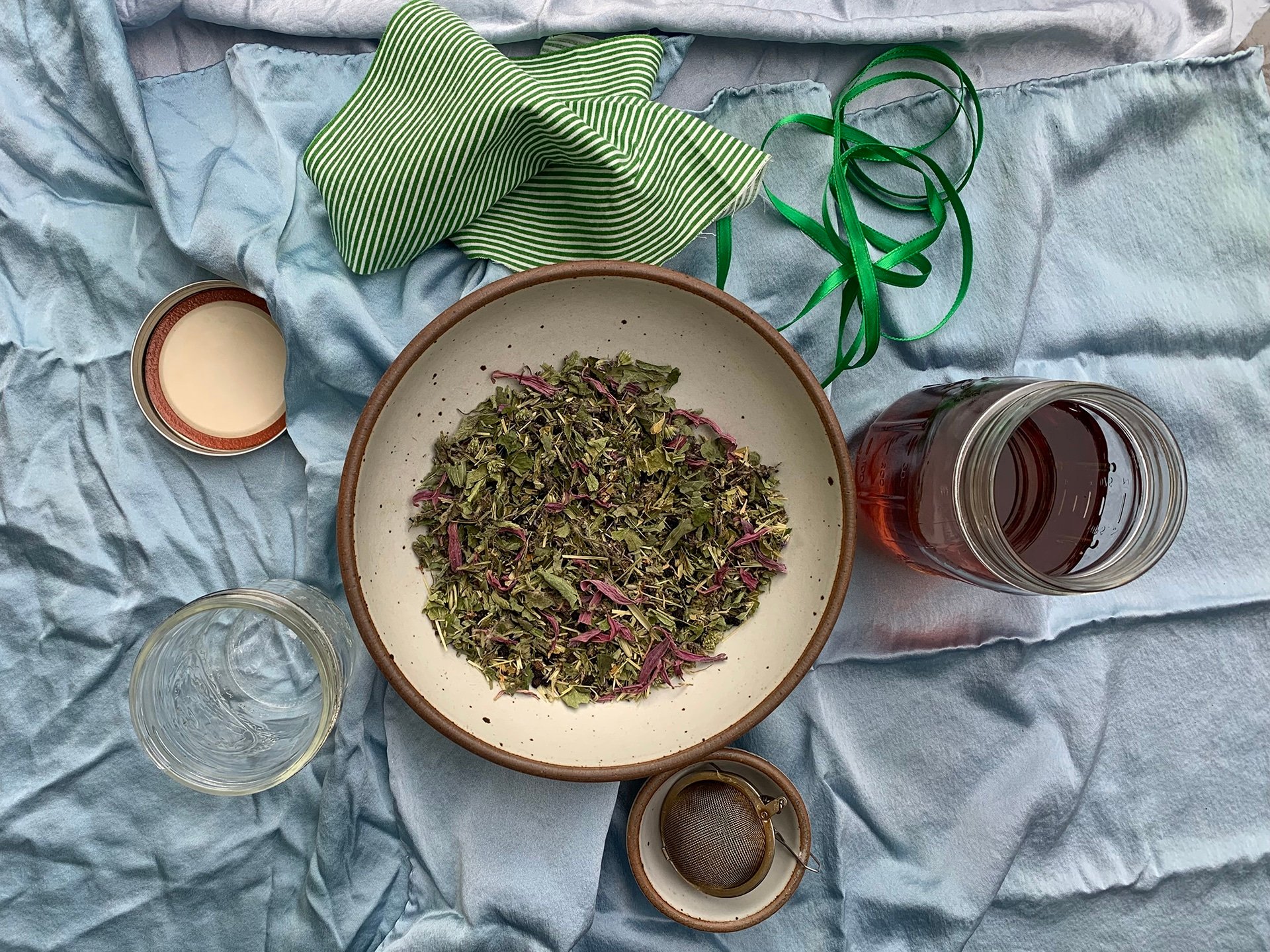

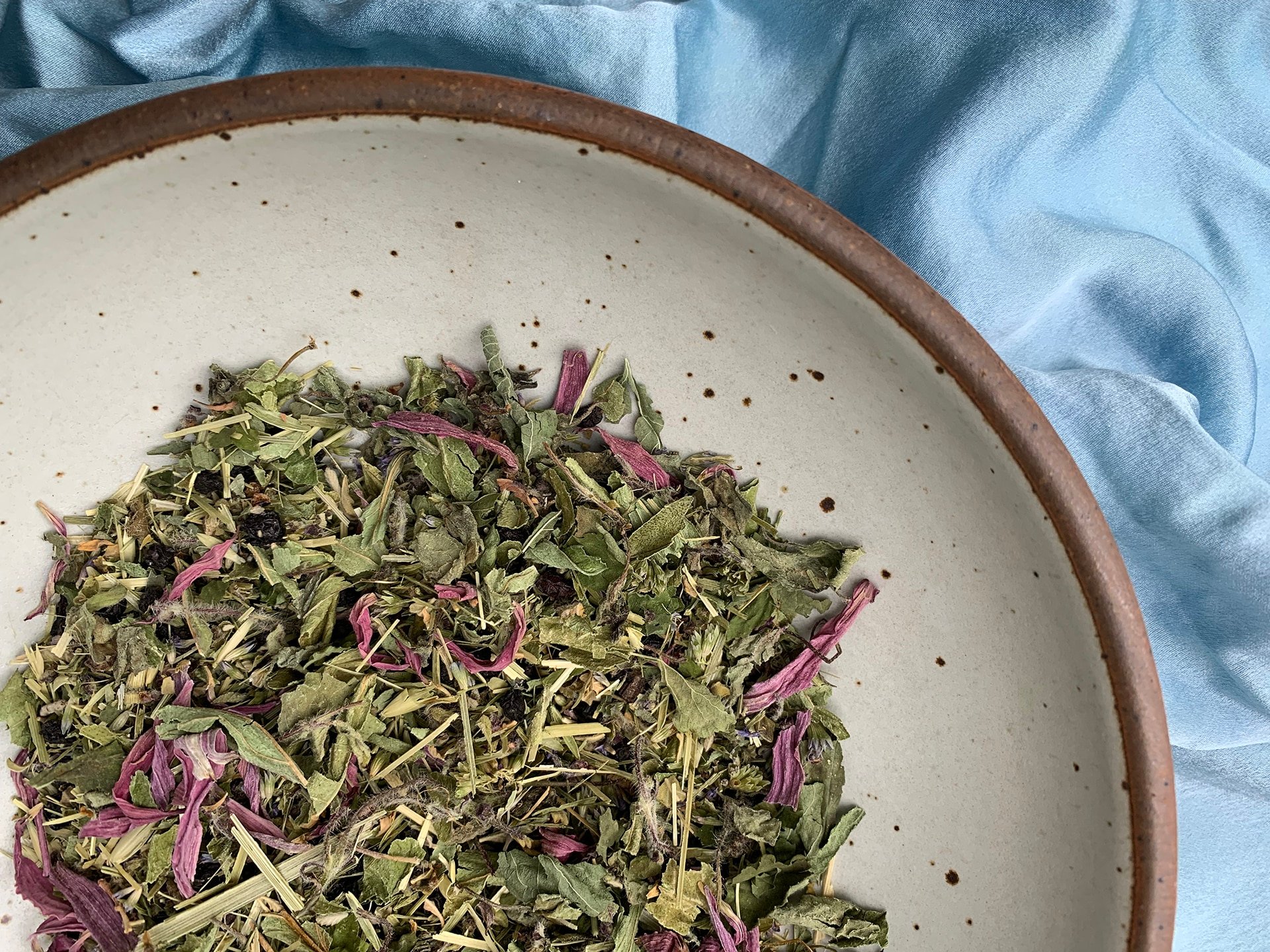
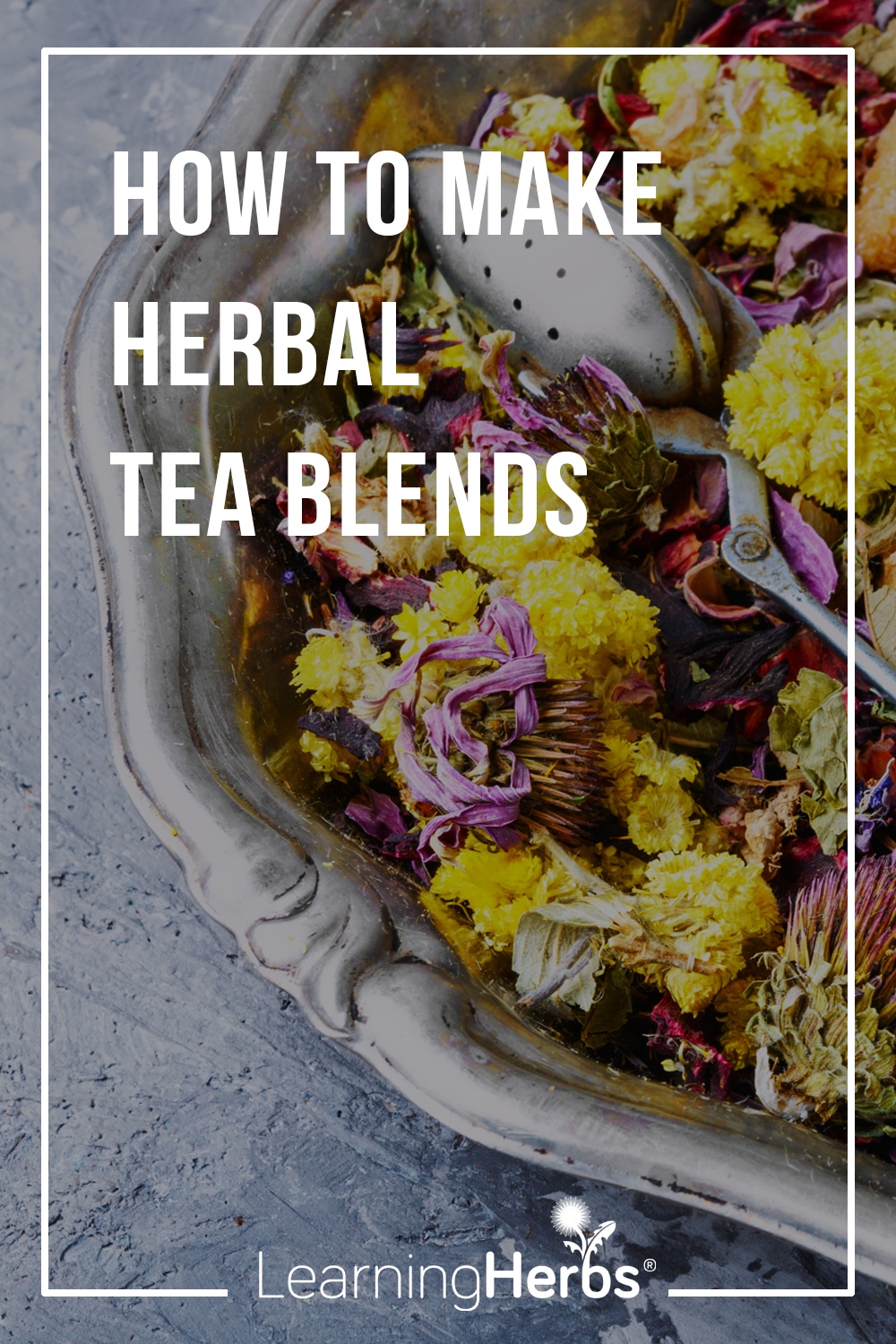
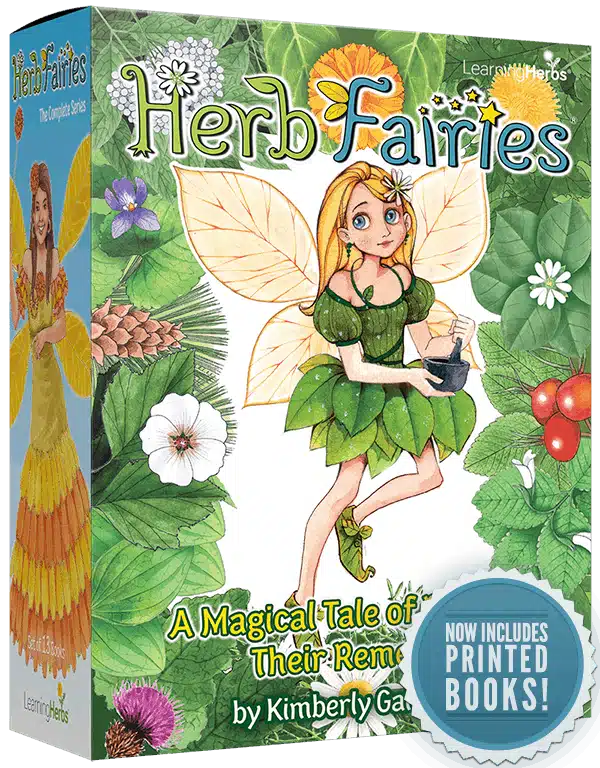





I love teas the flavor that the different flowers and mints taste, the smells are so enjoyable. always wanted to know more on what blends, plants go together and just how to make teas. also the different herb blends. Thank you
You are so very welcome! :)
Sounds delicious. Thank you!
You’re welcome! We hope you enjoy the recipes!
I would like to know more about tea formulation,thank you for the wisdom
Awesome! You’re welcome :)
looks and sounds like a lovely ea…..Thanks for the detailed instructions on blending and steeping
You’re welcome! We hope you enjoy :)